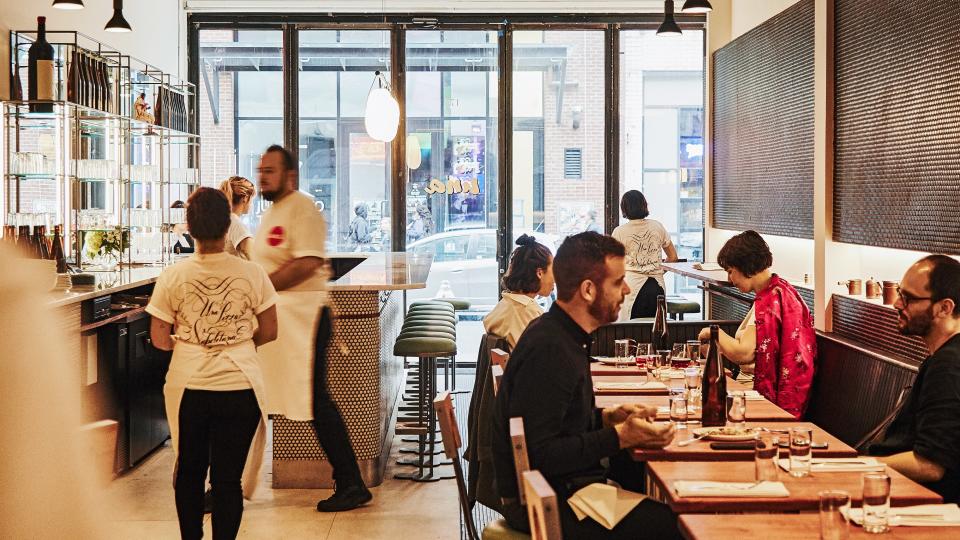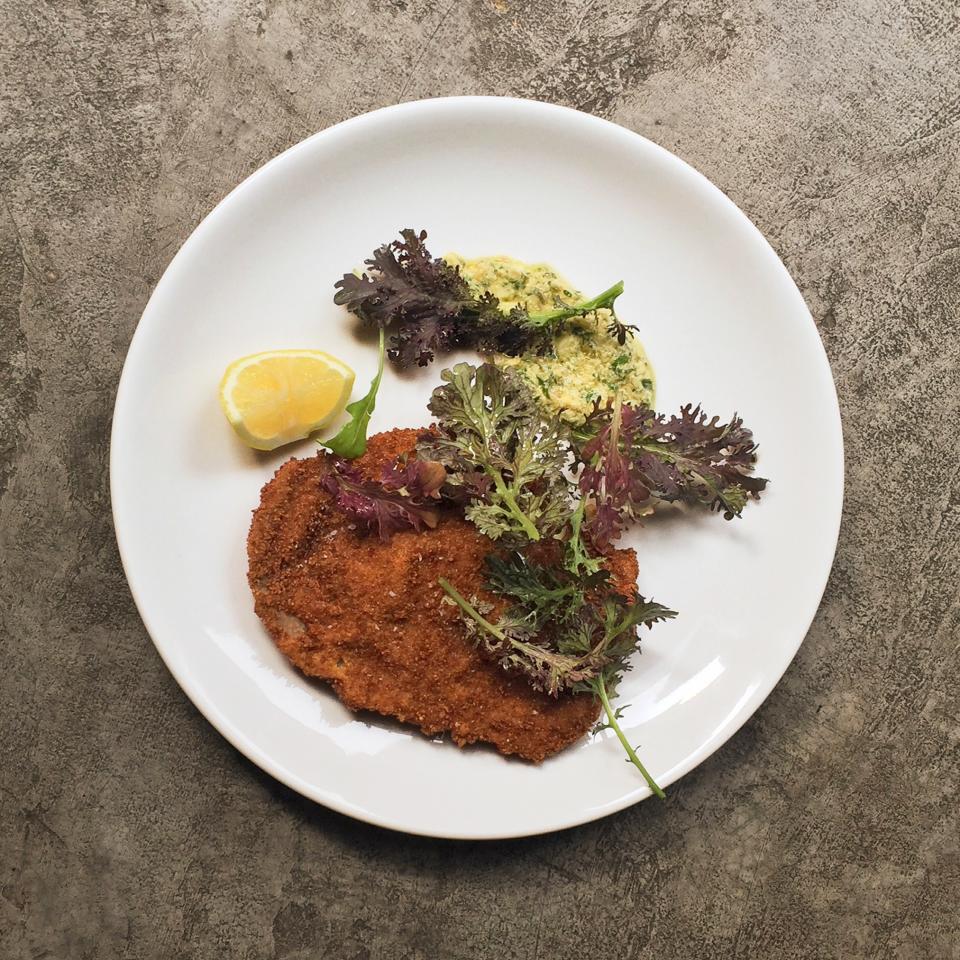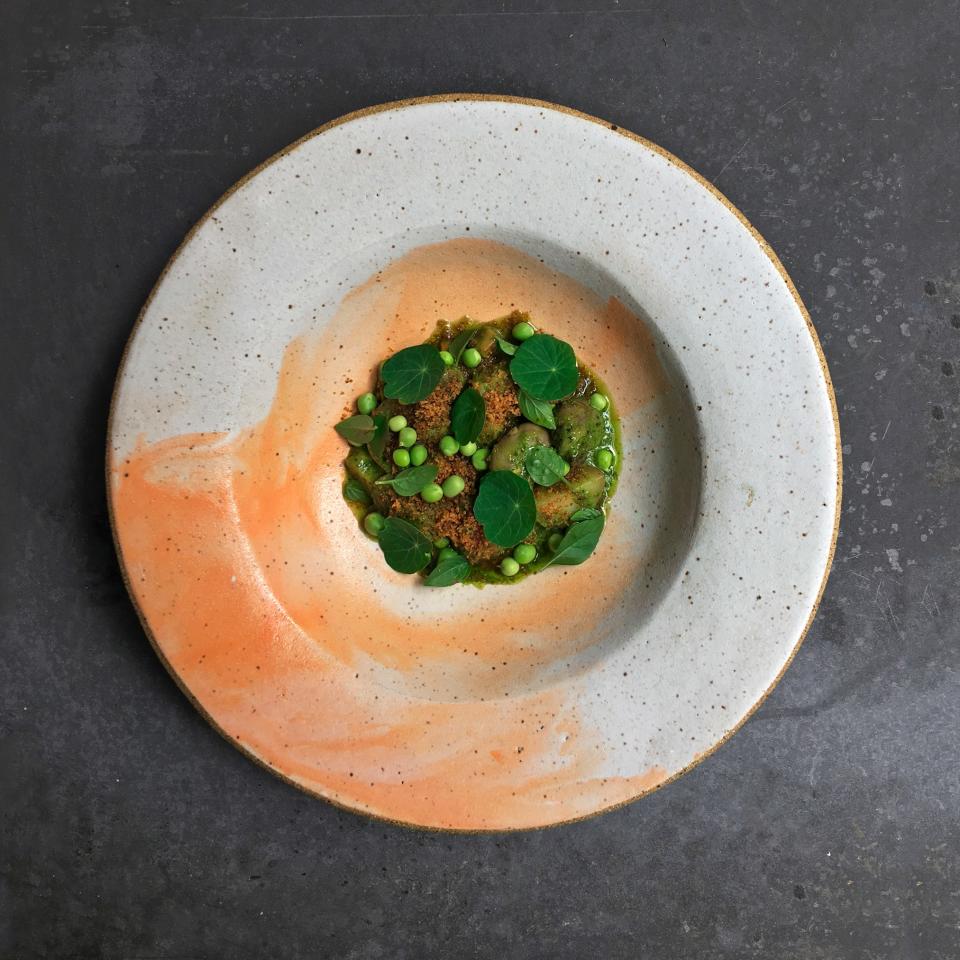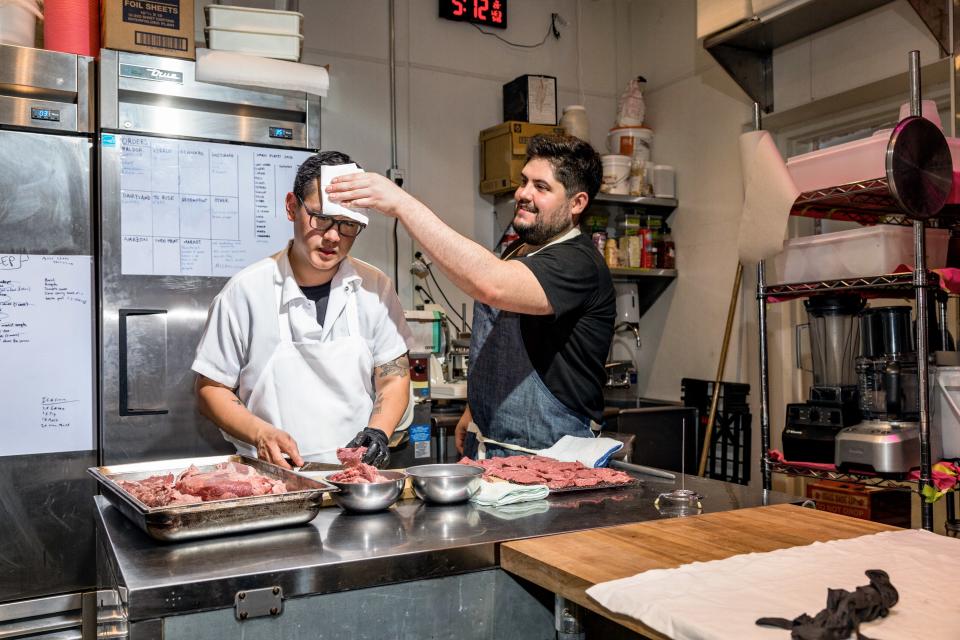This Is How You Make A Great Neighborhood Restaurant
In the year 2018, on the island of Manhattan, the buzziest restaurant opening was not a big-money expense-account spot or a high-budget new-French joint or another farm-to-table temple from some guy who's had his own dedicated season of television. It was a cozy and principled pizza place with penny-tile walls, natural wines, and a tiramisu so punchy and light it almost—almost—outshines the pies.
The restaurant is Una Pizza Napoletana, and it's the third from the BFF chef duo of Jeremiah Stone and Fabián von Hauske Valtierra. It's also a collaboration with a downtown legend, Anthony Mangieri, who opened the original Una Pizza Napoletana, in New Jersey, in 1996. Una Pizza sits on a crammed stretch of Orchard Street on New York's Lower East Side, just a couple blocks from their first two restaurants: Contra, a casual tasting-menu spot (more on that seeming paradox later), and Wildair, a neighborhood gem convincingly disguised as a cool wine bar. Within this stone's throw on the LES, the pair have built the most exciting restaurant group in a city where culinary ambitions are often trounced by high rents and even higher competition. And in doing so, they've become the best example of what's so great about eating out in America right now: that what's working—what is winning—is a style of restauranting that favors the enjoyment of the diner over the ego of the chef and that serves Michelin-star-level food without Michelin-star-level pretense.
Stone and von Hauske represent a new era of chef-restaurateurs who are creating tiny empires that express their own style of dining, where the casual and the quirky are valued over the tried and true—and having a few restaurants with highly specific personalities is far more effective (and financially viable) than trying to create a single fine-dining monolith. These restaurants care more about listening to diners and having a good time than adhering to any pre-existing script of what a “nice” restaurant needs to feel like. Creating a restaurant group, it turns out, doesn't have to mean taking over a city or replicating similar concepts in different neighborhoods; it's about finding the unique vibes that local diners are into and sprinkling them into a concentrated few blocks, betting that in those offerings there's something for everyone on any given night of the week.

It's easy to look at Contra, Wildair, and Una Pizza Napoletana, with their low-key decor and high-key natural-wine lists, and think that vibes are the main ingredient in their kitchens. These are, undoubtedly, cool restaurants. But this only proves the sly success of their cooking style, which is excellent but never showy, and generously lacking in fanciness.
There's an asceticism to Stone and von Hauske's flavors: Things are pared down but never plain. They favor acid over fat. Their style is more an act of restraint than anything, giving their dishes the effect of a duck in a pond—simple from the viewer's perspective, industrious beneath the surface. There is no tableside pouring of broth at Contra, no tweezer-applied garnishes, and very few animal intestines. When you open three restaurants in New York, where margins are slim and diners are flighty, twisting the knobs to dial into those things that will work takes an enormously delicate touch.
Expanding into second and third spaces meant growing up. “Opening next door really helped to open our eyes to see what doing something that is very inviting could do,” von Hauske says. “And also, just the maturity of being more welcoming, being more hospitable.” As their menus have gotten more “mature” as well, and as they've settled into the neighborhood, Stone and von Hauske have learned how to listen to their customers, and find a middle ground between the more out-there stuff they'd cook if they could and what their diners will actually eat.


“You're always going to have people that are like, ‘Oh, why don't you guys ever do duck tongues?’ ” Stone says. “And it's like, ‘Because I've got a guy who's not even going to eat beef tenderloin.’ ” Being able to accept those adaptations and let go of their own very specific visions for their restaurants has been integral to their success in a city where regulars—whether or not they live here—can make or break you. (Their 2019 project—a restaurant slash wine shop in the old Essex Street Market, where diners can taste wine and then go buy the bottle at retail prices next door—will be the furthest extension yet of this philosophy.) “We've really come around to understanding what kind of people are going to come in,” Stone says. “Nobody wants to be the experimental place, because then people can go and have one meal and they're like, ‘Yeah, it's nice, but it's not something I want to eat every day.’ We try to make food that people want to eat all the time.”
Watch:
The Ultimate Snack, According to Actor John David Washington
Three More Tiny Empires We Love
In Montreal, Paris, and New York, these chefs have made their neighborhoods far tastier places to visit
Joe Beef
Frédéric Morin and David McMillan's restaurant group turned Montreal's Little Burgundy neighborhood into one of the city's best, making its name on fearless yet classic meat cookery. “I don't mean to sound arrogant, but we have a very advanced dining public,” says McMillan. “I sell extensive amounts of liver.”
Septime
Chef Bertrand Grébaut has mastered the art of playing hard to get. His cultishly beloved Septime is one of Paris's most elusive reservations, but if you strike out, you can go down the street to Septime's wine bar, La Cave, for a glass of pét-nat before putting your name in at Clamato, his near perfect seafood restaurant.
Via Carota & Co
Rita Sodi and Jody Williams have built a family of deeply personal restaurants in the West Village inspired by their backgrounds in French and Italian cooking. (Via Carota, one of New York's most beloved restaurants, is modeled after Sodi's house in Italy.) “Each restaurant has character,” Williams explains, “and it's like a group of people.”
This story originally appeared in the December 2018/January 2019 issue with the title "The Biggest Thing In Restaurants Is...Tiny Empires."


